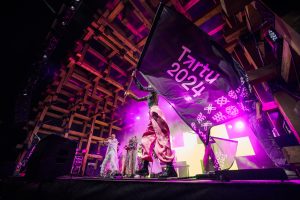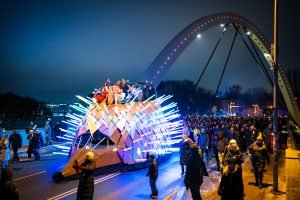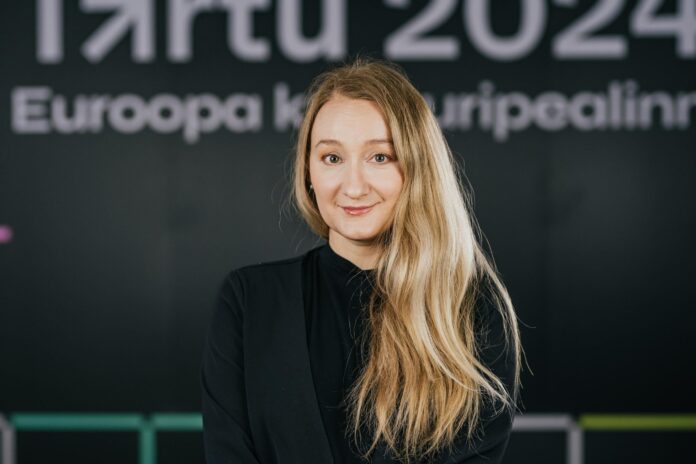Journalist’s Ain Alvela interview with the creative director of the European Capital of Culture Tartu 2024 Kati Torp.
The following year will pass in Tartu and Southern Estonia focusing heavily on the events of the European Capitals of Culture programme – among these are more than one thousand events, which all, in one way or another, tell the story of the Arts of Survival. About one million visits are expected at the events.
Arts of Survival is originality, sustainability, vigilance, and co-creation, or in other words the knowledge, skills, and values that will help us lead a good life in the future. This sums up the knowledge of Tartu and Southern Estonia as a community that the organizers want to share, and at the same time learn from others. The goal, according to the creative concept of the programme, is to create a better future inspired by culture.
In 2011 the European Capital of Culture was Tallinn. It is not a very common practice that the title of the European Capital of Culture is given to a larger region rather than a single town or a city. This year, the title is shared by three European regions – Tartu and Southern Estonia, Bad Ischl spa town and its surroundings in Austria and Bodø and Nordland region in Norway.
In Estonia, together with Tartu, Narva was another competitor for the title of the European Capital of Culture in 2024. The programme is funded by the municipality of Tartu, Estonian state, local municipalities, private sector, and European Union. The allocation of funds from the state is coordinated by Tartu 2024 foundation.
The opening event of Tartu 2024 was held on January 26, which could be freely enjoyed on site or over the Estonian Public Broadcasting live stream. What else is expected from the programme and what does this mean for Tartu, Southern Estonia and for the local people there, this is what I set out to find out from the creative director of the organizing committee of the capital of culture.

How did Tartu become the European Capital of Culture 2024 in the first place?
To receive the title of the European Capital of Culture, we had to have the idea of the creative concept ready by the time of the competition. We started with the preparations already at the end of 2017. During the next two years we phrased the main theme, which is the Arts of Survival. On the one hand, it was probably partly because of this idea that we were chosen, but on the other hand, also because Tartu set up its candidacy jointly with 19 South Estonian municipalities. This is about quarter of Estonia. We expressed our faith and ability to welcome large number of visitors, and perhaps that great cooperative power proved to be significant and convincing.
To what extent is Tartu 2024 trying to introduce to wider audiences our culture and to what extent our local way of living in general?
We see our idea as a wide umbrella, which covers as many different areas as possible, and which can also be expanded in new directions. It includes visual arts, theatre, music as well as literature, but there is also big part in food and traditional culture in the programme. So yes – the events go beyond the boundaries of culture in the usual sense, also involving local uniqueness, traditions and the change of these over time.”
To what extent could the events taking place in South Estonia also boost the self-awareness of the local population and to raise the awareness of their belonging to the European cultural space?
I hope that very much so. The whole idea behind the European Capital of Culture initiative is to help to initiate a positive change in the local region. Socio-economic change, in particular. The Capital of Culture programme is, in a good sense, a tool for carrying out this change. That is why I believe that many activities continue to develop also after 2024, and that we will have contributed to the creation of fertile ground for them.
What does the creative concept exactly consist of?
There are four different topics, intertwined into whole. One of these is Uniqueness and Europe, which among other things, explores the uniqueness of South Estonia, in some cases also through unconventional culture. For example, by introducing traditions, crafting skills, languages etc. What is important, is that Southern Estonians, when telling these stories, would see themselves as part of European cultural space. In addition, cooperation points with Europe are being sought. Most events are around this general topic.
The second topic is Life and Environment, which is dedicated to themes like environment, climate problems, but also to the connections of urban and rural spaces to nature. So, one of the projects talks about creating diverse biodiversity in the urban space of Tartu. Elsewhere, there are initiatives that analyse the relationship between technology and the environment or deal with the concerns of marginalization.
The third topic is Human and Skills, which explores activities related to traditions, handicraft, and local farmwork. But also sports and mental health, which is all part of being a human in the XXI century and of the knowledge that we need for coping better as a community. Within this topic, the Tartu City Museum, Estonian Agricultural Museum and Estonian Road Museum are conducting activities under the collective name “Washing Machine Made of Beetroot” exploring the ingenuity of inventions of soviet era people, without which it would have been nearly impossible to survive. In this way, European people could get a better idea of who we are and what kind of recent history we have had. In cooperation with mental health organization Peaasi we have some events, including mental health coffees, stand up shows etc, with the aim of talking about these difficult themes through humour. This general topic also includes the extreme sports event Simple Session, which is again held in Tartu this year. But also, the Paganlik Pärimusöö – pagan folklore night held in Võrumaa.
The fourth topic is Science and Technology, which introduces Tartu as a university city and innovation centre, but also revolves around the development of science-based technology in general. When we started, many of our undertakings were revolutionary for the time, but by now, for example waste sorting has become part of the everyday normality.

If you were to single out one event with some expected wider audience, what would it be?
For example, the documental film project, during which eight new short documentaries will be created, four by local filmmakers, four by filmmakers from abroad. This is a work with a long preparation period, as we had several filmmakers from around the world in residence, from whose ideas these films were finally selected. As a result, a cassette with eight films was created, all depicting different activities, peculiarities, and local people from Southern Estonia, also of interest to a wider audience. The films will be completed by the beginning of May and will be screened in cinemas, and hopefully eventually also on TV.
How much have the current issues influenced the programme? The kind that no one could have foreseen or planned five years ago.
We have tried to reflect the ongoing war in Ukraine. On the one hand, explaining the war and the destinies of the people there to Europe, on the other hand, also trying to provide outlets for Ukrainian creatives in our programme. So, between February 25 and 27 there is a film programme at the Estonian National Museum called “Ukraine: Breakthrough Years” exploring the war years, which includes Ukrainian themed documental films created by Ukrainian authors. We are often asked from Europe what it is like to live right next to the Russian border. One of our events, Treski Inspiration conference, is held in Treski village in Setomaa, located just some kilometres from the Russian border.”
How can one participate in all these events? Is it only on site or is it also possible to watch them via the internet or television?
The bigger events have already been and will be in the future broadcasted via TV. Indeed, many of the projects, were originally planning to also include some hybrid solutions, but have by now given up, as apparently the corona-era enthusiasm for transferring activities via the network has subsided by now. But there are some events, like the hybrid opinion festival, jointly organized by the students at Tartu University and European universities, during which, among other things, there are direct connections between different stages here and in elsewhere Europe, bringing the discussion digitally together in one place. And I believe there will be recordings of some events, some works of art created, sound recordings, etc, that will carry on the story of Tartu 2024 in the future. But these cannot, in most cases, replace the physical experience, of course.
How will everyone understand each other and what is happening on the stages, as people of different nationalities in addition to local people are expected to take part in the events?
We have considered three languages – Estonian, English, and Russian. If the project managers have the capacity, they can make themselves understood in, for example, Ukrainian or another language. In most of the museums, materials are already available in different languages anyway. We have established accessibility criteria that must be considered at each event. For example, the availability of subtitles, but also, whether persons with special needs can attend, whether the event is free or with a ticket, etc.
You had probably accounted for quite many visitors from Russia, but as the situation has changed, they are not coming. Is that something you worry about?
Yes, we did indeed. In terms of marketing, we had mapped out the most important target countries, and in the beginning, Russia was indeed one of these countries. After the beginning of the Ukrainian war, Russia of course fell off, we are not doing any cooperation with them anymore and chose Great Britain as a new target country. In addition, Finland, Latvia, Lithuania, and Germany. But we are still communicating to the local Russian-speaking community and are hoping for them to take part in the events.

How many events take place elsewhere in Estonia outside the European Capital of Culture geographical boundary?
Our project managers conduct marketing activities in other regions or plan to conduct follow-up events there. We have some stand-up events that have already taken place in Tallinn – which can be attended individually, but at the same time invite people over to the capital of culture. Some larger concerts will also be held in Tallinn, Pärnu, Jõhvi, or even in Latvia and elsewhere.
How is the use of symbols of the capital of culture regulated?
It is an interesting topic. Some capitals of culture have released their logos for free use. Everyone could use them. We solved it in a way that logo may be used by projects that are co-financed by the Tartu 2024 foundation, which follow a certain criterion and belong to the main programme. In addition, our marketing channels, including the logo, may be used by other event organizers if those events harmonize with our own programme, do not conflict our values and belong to the so-called supplementary programme. To do so, an application from our website must be filled.
What is the measure for the quality and efficiency for the work you are doing as organizers, that you can later evaluate yourself according to?
Metrics are clear and should be understandable to everyone. We have hired a specialist who is observing all kinds of data daily and is drawing conclusions based on them. This includes our environmental footprint, but also how many people attended one or another event, how much money they left behind for the local area, and how we have met the targets that we have set. One of our big goals is to gather one million visits. It is certainly also important what the cultural media thinks of our activities – what is considered a success and what is not. I believe that a year from now in February we can start to make conclusions.
What is causing the most anxiety right now?
It is probably accommodation. If we expect and wish that the people coming from further away will stay here as long as possible, then they must have somewhere to stay. Metallica concert and Rally Estonia have shown how all the places of accommodation in Tartu have been sold out and it is still not enough. We have given local people the opportunity to offer their vacant living spaces to accommodate visitors. But this problem will not go away, and we will still have to deal with this during the coming year. We also try to cooperate with tourist information points so that all information, including accommodation, is available there.
“The events of Tartu 2024 events go beyond the boundaries of culture in the usual sense, also touching on local uniqueness, traditions and their changes over time,” Kati Torp.

